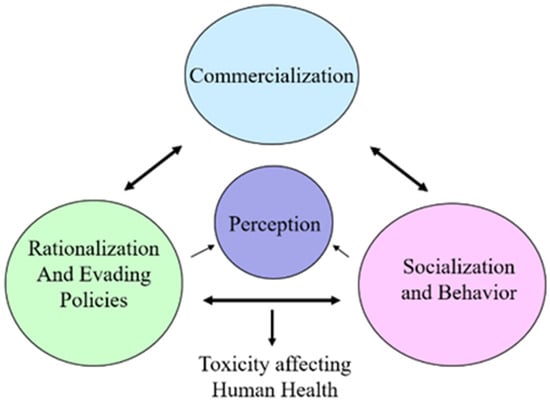
| Version | Summary | Created by | Modification | Content Size | Created at | Operation |
|---|---|---|---|---|---|---|
| 1 | Irfan Rahman | -- | 1205 | 2023-05-02 16:23:46 | | | |
| 2 | Lindsay Dong | Meta information modification | 1205 | 2023-05-03 04:40:09 | | |
Video Upload Options
Oral Nicotine Pouches (ONPs) are the new form of nicotine pouches that have become a type of emerging smokeless tobacco product sold by various tobacco companies. These smokeless tobacco products are marketed for usage all over as snus containing tobacco-derived nicotine (natural) or as tobacco-free nicotine (synthetic) as substitutes for other tobacco products. Based on perception and socio-behavioral aspects, ONPs have become popular tobacco products among adolescents/young adults, and over 50% of young adult users of ONP use flavored ONPs, such as menthol/mint, tobacco, dessert/candy, and fruity, which are the most popular flavors. Various new ONP flavors are currently popular locally as well as in the online market. Tobacco, menthol, and fruit-flavored ONPs could motivate cigarette smokers to change to ONPs.
1. Introduction
2. Social Behavioral Aspects of Oral Nicotine Pouches
3. Commercialization, Perceptions, and Illusions of Nicotine Products

- (1)
-
Commercialization is the process by which unregulated policies are enacted as a matter of routine, often without conscious thought about their propriety or based on scientific knowledge;
- (2)
-
Rationalization, or evading policies, involves the process by which individuals who engage in usage accept socially constructed accounts that artificially legitimize the acts in their own eyes and perceptions;
- (3)
-
Socialization, or behavior changes, involve the process by which newcomers are thought to perform and accept the usage as a norm or alternative to smoking.
References
- Czaplicki, L.; Patel, M.; Rahman, B.; Yoon, S.; Schillo, B.; Rose, S.W. Oral nicotine marketing claims in direct-mail advertising. Tob. Control 2022, 31, 663–666.
- Mallock, N.; Schulz, T.; Malke, S.; Dreiack, N.; Laux, P.; Luch, A. Levels of nicotine and tobacco-specific nitrosamines in oral nicotine pouches. Tob. Control 2022.
- Keogh, A. Nicotine Pouches. Br. Dent. J. 2021, 230, 61–62.
- Food and Drug Administration. Smokeless Tobacco Products, Including Dip, Snuff, Snus, and Chewing Tobacco. 2020. Available online: https://www.fda.gov/tobacco-products/products-ingredients-components/smokeless-tobacco-products-including-dip-snuffsnus-and-chewing-tobacco (accessed on 1 December 2022).
- Food and Drug Administration. Dissolvable Tobacco Products. 2018. Available online: https://www.fda.gov/tobacco-products/products-ingredients-components/dissolvable-tobacco-products (accessed on 1 December 2022).
- Robichaud, M.O.; Seidenberg, A.B.; Byron, M.J. Tobacco companies introduce ‘tobacco-free’nicotine pouches. Tob. Control. 2020, 29, e145–e146.
- Delnevo, C.D.; Hrywna, M.; Miller Lo, E.J.; Wackowski, O.A. Examining market trends in smokeless tobacco sales in the United States: 2011–2019. Nicotine Tob. Res. 2021, 23, 1420–1424.
- European Commission. Meeting of the Group of Experts on Tobacco Policy. 2019. Available online: https://ec.europa.eu/transparency/expert-groups-register/screen/meetings/consult?do=groupDetail.groupMeeting&meetingId=16984 (accessed on 7 July 2022).
- Tactics, T.; University of Bath. Nicotine Pouches. 2021. Available online: https://tobaccotactics.org/wiki/nicotine-pouches/ (accessed on 7 July 2022).
- Bishop, E.; East, N.; Bozhilova, S.; Santopietro, S.; Smart, D.; Taylor, M.; Meredith, S.; Baxter, A.; Breheny, D.; Thorne, D.; et al. An approach for the extract generation and toxicological assessment of tobacco-free ‘modern’oral nicotine pouches. Food Chem. Toxicol. 2020, 145, 111713.
- Rutqvist, L.E.; Curvall, M.; Hassler, T.; Ringberger, T.; Wahlberg, I. Swedish snus and the GothiaTek® standard. Harm Reduct. J. 2011, 8, 11.
- Coggins, C.R.; Ballantyne, M.; Curvall, M.; Rutqvist, L.E. The in vitro toxicology of Swedish snus. Crit. Rev. Toxicol. 2012, 42, 304–313.
- Plurphanswat, N.; Hughes, J.R.; Fagerström, K.; Rodu, B. Initial information on a novel nicotine product. Am. J. Addict. 2020, 29, 279–286.
- Ashforth, B.E.; Anand, V. The normalization of corruption in organizations. Res. Organ. Behav 2003, 25, 1–52.
- Berger, P.; Luckmann, T. The Social Construction of Reality; Routledge: Oxfordshire, UK, 1966; pp. 110–122.
- Boyer, E.W.; Levy, S.; Smelson, D.; Vargas, S.; Casey, A. The clinical assessment of vaping exposure. J. Addict. Med. 2020, 14, 446–450.
- Clarke, D.B.; Kapoor, D.; Baird, A.M.; Buchanan, P.J.; Gately, K.; Cuffe, S.; Finn, S.P. Vaping and lung cancer—A review of current data and recommendations. Lung Cancer 2021, 153, 11–20.
- Harlow, A.F.; Vogel, E.A.; Tackett, A.P.; Cho, J.; Han, D.H.; Wong, M.; Cockburn, M.G.; Sussman, S.Y.; Unger, J.B.; Leventhal, A.M.; et al. Adolescent use of flavored non-tobacco oral nicotine products. Pediatrics 2022, 150, e2022056586.
- Vogel, E.A.; Barrington-Trimis, J.L.; Harlow, A.F.; Wong, M.; Cho, J.; Han, D.H.; Leventhal, A.M.; Tackett, A.P. Prevalence of and disparities in adolescents’ susceptibility to novel oral nicotine products marketed as “tobacco-free”. Prev. Med. 2022, 9, 107387.
- Vogel, E.A.; Barrington-Trimis, J.L.; Kechter, A.; Tackett, A.P.; Liu, F.; Sussman, S.; Lerman, C.; Unger, J.B.; Hughes Halbert, C.; Chaffee, B.W.; et al. Differences in young adults’ perceptions of and willingness to use nicotine pouches by tobacco use status. Int. J. Environ. Res. Public Health 2022, 19, 2685.
- Nitzkin, J.L. E-cigarette primer for state and local lawmakers. RStreet 2014, 25, 1–13.




